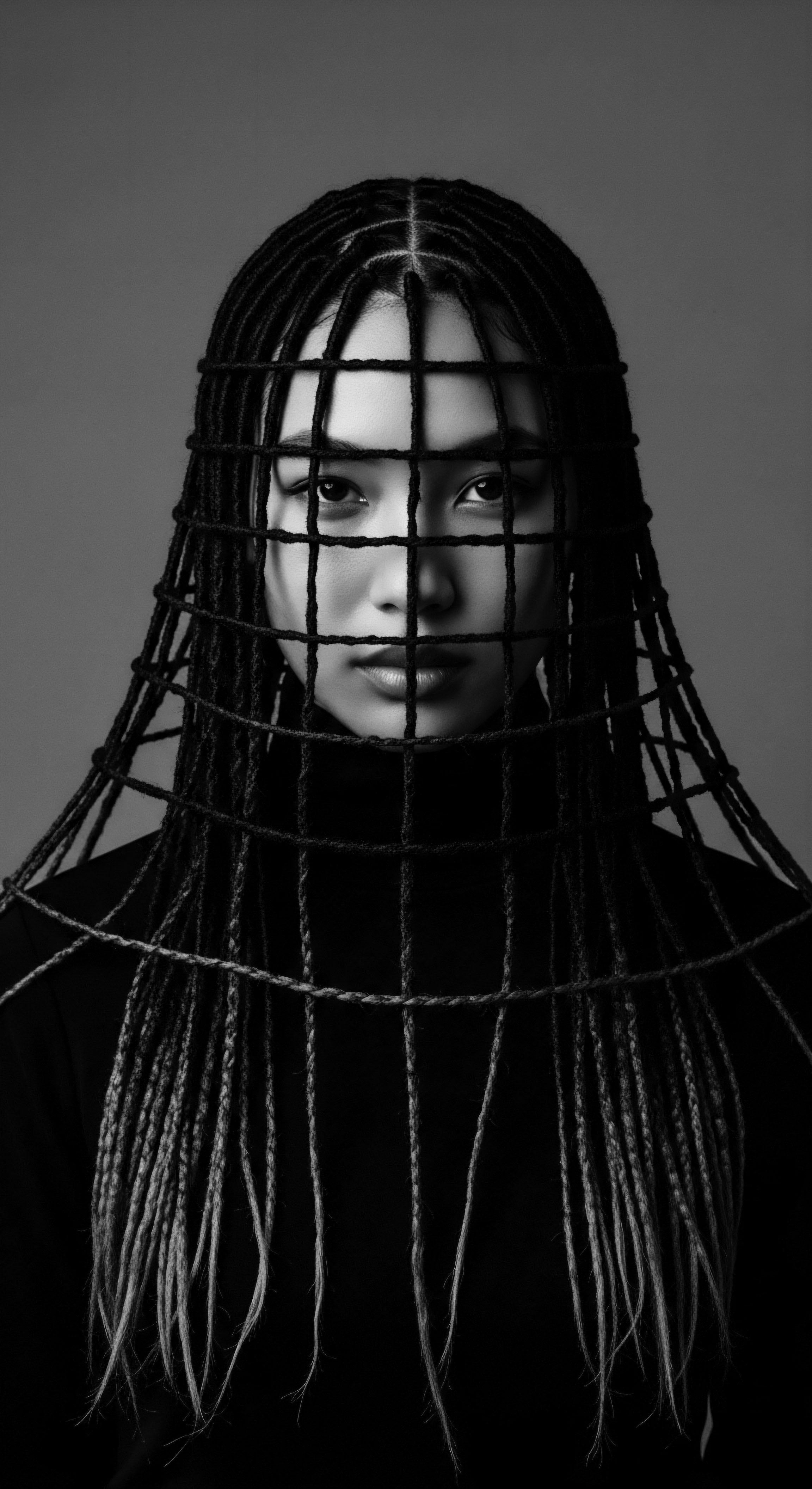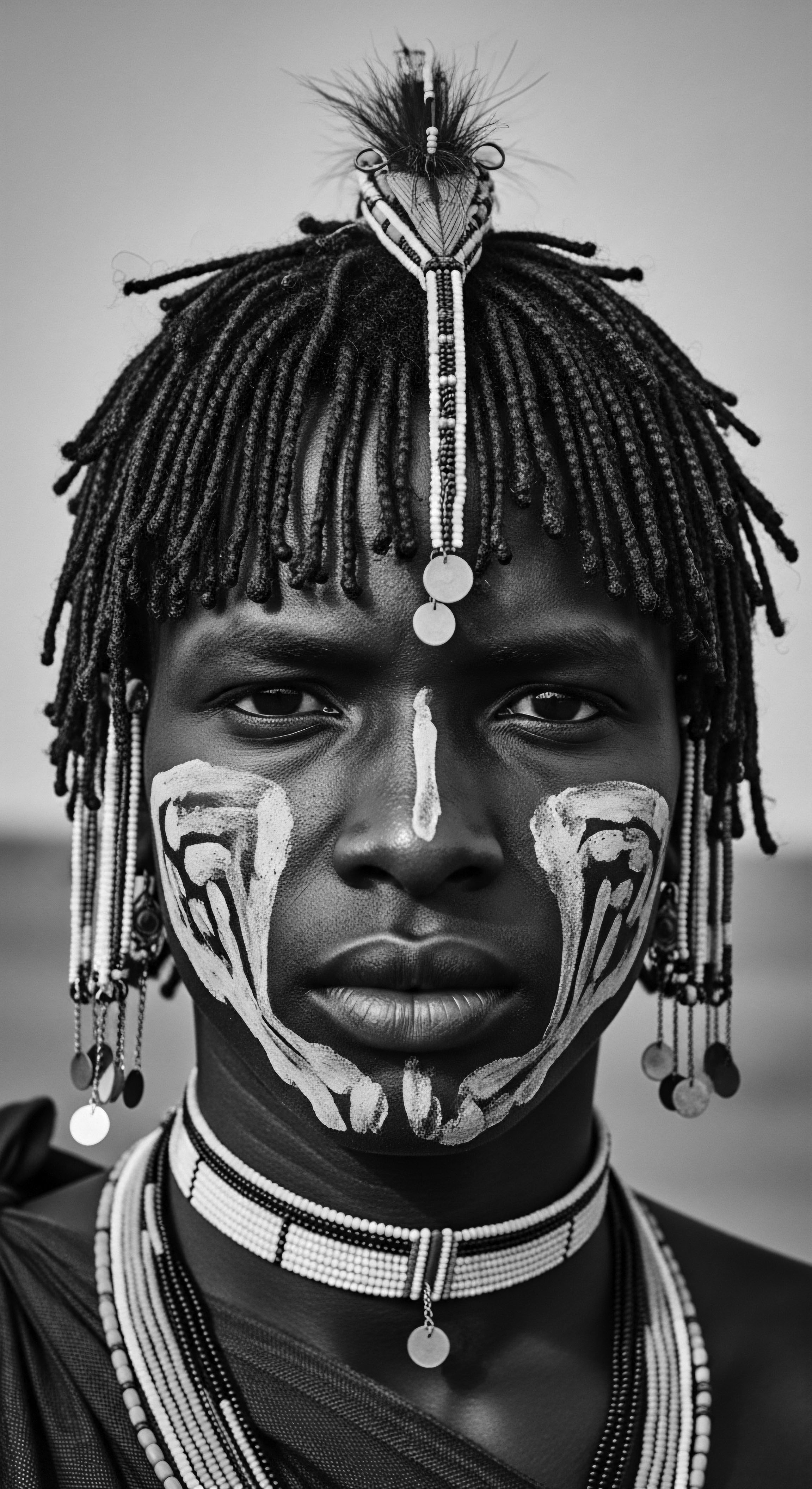
Roots
For those of us whose hair tells stories untold by straight lines, a strand of textured hair is more than mere protein and pigment. It is a chronicle, a living parchment bearing the echoes of countless generations. When we ask, “Can ancestral wisdom truly elevate modern textured hair practices?”, we are not simply seeking techniques or ingredients. We are peering into a profound memory, a collective heritage etched into every coil, wave, and zig-zag.
It is a whisper from foremothers, a tangible link to ancient ways of knowing, being, and beautifying. This exploration begins at the very root, examining the hair itself, not as an isolated biological phenomenon, but as a deeply embedded aspect of identity, community, and historical perseverance.
Consider the intricate biology of textured hair, a marvel of natural architecture. Unlike straight hair, which tends to grow in a perfectly round cross-section from a straight follicle, hair with more definition emerges from an oval or even flat follicle, curving as it grows. This helical structure, varying from gentle waves to tightly packed coils, dictates its unique characteristics ❉ its incredible volume, its propensity for shrinkage, and its inherent need for moisture. For centuries, long before microscopes revealed follicular secrets, ancestral communities possessed an intuitive understanding of these properties.
They observed how certain climates affected their hair, how particular plant extracts softened or strengthened it, and how various manipulations preserved its integrity. Their knowledge arose from generations of observation, experimentation, and transmission.

The Hair’s Intrinsic Form
Understanding the hair’s inherent nature, from its distinct curl pattern to its porosity, is the foundational step. The way light refracts off a tightly coiled strand, or how water absorbs into a highly porous one, were not abstract concepts for our ancestors. They were lived realities that guided their daily care. They learned that moisture was a precious commodity, easily lost from the expansive surface area of curled strands.
They understood that forceful manipulation could compromise the hair’s delicate structure. This understanding, gleaned through experience, formed the basis of their care rituals.
- Curl Pattern ❉ The distinctive shape of the hair strand, ranging from loose waves to tight coils. Ancestors recognized these varied forms and developed specific manipulations for each.
- Porosity ❉ The hair’s ability to absorb and retain moisture. Traditional practices often involved sealing in moisture with natural oils and butters to counter rapid evaporation.
- Elasticity ❉ The hair’s capacity to stretch and return to its original state. Gentle handling, a hallmark of ancestral care, helped preserve this vital quality.

Categorizing Hair Through Time
Modern classification systems, like those using numbers and letters, attempt to categorize hair patterns with scientific precision. But how did ancestral societies, without such frameworks, differentiate and speak of hair? Their systems were often rooted in cultural significance, spiritual meaning, or functional applications. Hair was not just hair; it was a map, a symbol, a declaration.
A particular texture might signify tribal belonging, marital status, or a period of mourning. The language used to describe hair was, therefore, deeply interwoven with social fabric, reflecting a communal understanding of its various manifestations. The meticulous care prescribed within these communities often reflected these intrinsic qualities, passed down through oral tradition and practical demonstration.
This traditional lexicon, rich with descriptive terms for texture, length, and adornment, serves as a powerful reminder that our connection to textured hair is not a recent discovery. It is an ancient lineage. These terms often spoke to the hair’s very movement, its sheen, or its ability to hold a particular style, reflecting a comprehensive and lived appreciation for its unique characteristics.
Ancestral wisdom provides a deep lens through which to comprehend the very essence of textured hair, far beyond its biological blueprint.

Ritual
The true power of ancestral wisdom begins to manifest not just in what our forebears understood about hair, but in what they did with that knowledge. Their practices were not isolated acts of vanity; they were rituals, deeply embedded in daily life, communal gatherings, and rites of passage. These ‘rituals of hair’ embodied a holistic approach, where care, community, and identity were inextricably linked. The question “Can ancestral wisdom truly elevate modern textured hair practices?” finds its living answer in these long-standing traditions, offering a blueprint for care that transcends superficial trends.
Across the African diaspora, the act of hair styling was often a communal affair, a time for sharing stories, transmitting values, and strengthening bonds. Grandmothers would teach granddaughters, mothers would instruct daughters, and communities would gather, their hands working in tandem. This collective engagement ensured the continuity of specific techniques and the oral transmission of knowledge regarding the properties of plants, the art of tension, and the geometry of braids. The rhythmic sounds of braiding, the gentle murmurs of conversation, and the shared space transformed a simple act of grooming into a profound cultural ceremony.

Protective Styling ❉ A Heritage of Shielding
Protective styling, a cornerstone of modern textured hair care, finds its most profound roots in ancestral practices. For centuries, braids, twists, and locs served not only as expressions of beauty but as essential defenses against the elements, laborious work, and daily wear. These styles were ingenious solutions for preserving hair length, minimizing breakage, and maintaining scalp health.
The intricate patterns of cornrows, for instance, found across various West African cultures, were not arbitrary designs. They often carried symbolic meaning, communicated social status, or even represented maps of escape routes during periods of enslavement.
The longevity and resilience of these styles demonstrate an intuitive mastery of hair manipulation. Tension was carefully calibrated to avoid undue strain on the scalp, and natural lubricants were applied to keep strands supple and reduce friction. These are not merely historical footnotes; they are living testaments to the efficacy of practices that continue to guide modern approaches to maintaining textured hair health.
- Cornrows ❉ Found throughout African cultures, these intricate braids lie flat against the scalp, minimizing manipulation and protecting hair from external damage.
- Bantu Knots ❉ Originating from Southern Africa, these tightly coiled knots protect the ends of the hair and help set curl patterns, embodying both utility and aesthetic.
- Locs ❉ A spiritual and cultural statement for many, locs are a form of protective styling that allows hair to coil and interlace naturally, requiring minimal daily intervention once established.

Nighttime Sanctum ❉ The Wisdom of Sleep Protection
The ritual of nighttime hair protection is a particularly telling example of ancestral foresight. Before the advent of silk bonnets or satin pillowcases, communities understood the importance of shielding hair during sleep. Head wraps, often made from natural fibers, served to preserve styles, retain moisture, and protect the hair from friction against rough sleeping surfaces.
This practice highlights a deep, inherited wisdom ❉ that healthy hair requires consistent care, even through the hours of rest. Modern sleep accessories are, in essence, a continuation of this long-held tradition, offering a convenient way to replicate the protective benefits our ancestors instinctively understood.
Ancestral hair practices, from communal styling to nocturnal wraps, offer more than techniques; they provide a holistic framework for hair health rooted in heritage.
These rituals, passed down through generations, were often accompanied by chants, songs, or stories, further embedding the practice within a communal and spiritual context. The hair became a recipient of not only physical care but also ancestral blessings and collective intention.
| Ancestral Tool/Practice Fine-Toothed Combs (e.g. from Ghanaian Ashanti) |
| Purpose and Heritage Used for detangling, parting, and symbolic hair sculpture, often crafted from wood or bone, reflecting spiritual significance. |
| Modern Parallel/Elevation Wide-tooth combs and detangling brushes, designed to minimize breakage on textured hair. |
| Ancestral Tool/Practice Natural Fiber Wraps (e.g. woven cloths) |
| Purpose and Heritage Protected hair during sleep or work, retained moisture, and maintained elaborate styles. |
| Modern Parallel/Elevation Satin bonnets, silk scarves, and satin pillowcases, mitigating friction and moisture loss overnight. |
| Ancestral Tool/Practice Gourd Bowls & Pestles |
| Purpose and Heritage Preparation of plant-based cleansers, conditioners, and styling agents; a communal activity for knowledge transfer. |
| Modern Parallel/Elevation Mixing bowls and application brushes in modern product creation, emphasizing fresh, custom formulations. |
| Ancestral Tool/Practice The enduring wisdom of ancestral hair tools reminds us that effective care often rests on simple, well-applied principles. |

Relay
To consider whether ancestral wisdom can truly elevate modern textured hair practices requires a deep, uncompromising look at the tangible legacy these traditions have left us, especially in the realm of ingredients and holistic well-being. It is here, in the convergence of ancient observation and contemporary scientific validation, that the profound answers lie. This is where the wisdom of the past does not simply inspire, but actively informs and enriches our present understanding. The relay of knowledge across centuries reveals that what was understood by our ancestors, through empirical experience, often aligns with what modern laboratories now confirm through molecular analysis.

What Specific Ancestral Ingredients Carry Power Today?
The pantries and fields of our foremothers were pharmaceutical hubs. They knew the restorative properties of shea butter, extracted from the nuts of the African shea tree, long before it became a global cosmetic staple. Its rich fatty acid profile and natural vitamins were instinctively applied to moisturize, protect, and soothe scalp ailments.
Similarly, Argan Oil, from the Moroccan argan tree, was prized for its conditioning and reparative qualities. These were not random choices; they were the result of generations of meticulous observation and practical application.
One particularly compelling example, less widely recognized in mainstream discourse but deeply rooted in ancestral practice, is the Chebe Tradition of the Basara Arab women in Chad. For centuries, these women have used a blend of Chebe powder (a mix of local herbs and seeds), karkar oil, and animal fat to cultivate remarkably long, strong, and healthy hair. The process involves moistening the hair, applying the Chebe mixture, and then braiding it, repeating the process over days or weeks. This ritual, documented ethnobotanically, prioritizes moisture retention and protection from breakage, allowing the hair to reach impressive lengths (Ounah, 2018).
While the specific chemical mechanisms are still being explored, the efficacy observed over generations suggests an intuitive understanding of protective styling and the benefit of consistent moisture and protein application. This practice, passed down through matriarchal lines, perfectly illustrates how focused, repetitive ancestral care, centered on natural ingredients and minimal manipulation, directly addresses the inherent needs of highly textured hair.
The validation of traditional ingredients by modern science confirms the profound efficacy of ancestral knowledge, bridging ancient wisdom with contemporary understanding.

How Do Ancestral Wellness Philosophies Shape Hair Health?
Beyond topical applications, ancestral wisdom often viewed hair health as an extension of overall physical and spiritual well-being. The diet, for instance, played a significant role. Communities subsisted on whole, unprocessed foods rich in vitamins and minerals, which directly nourished hair follicles from within. Fermented foods, diverse plant-based diets, and traditional healing herbs contributed to a robust internal environment, fostering hair growth and vitality.
The concept of hair as a spiritual antenna, a connection to the divine or to one’s lineage, also meant that its care was imbued with reverence and intention. This holistic perspective, where mind, body, and spirit were intrinsically linked, meant hair care was never just superficial.
For our ancestors, solving hair problems often involved a blend of herbal remedies, dietary adjustments, and specific manipulations. For instance, addressing issues like dryness or breakage might involve a combination of specific herbal rinses, increased intake of nourishing foods, and adjustments to protective styling routines. This integrated approach stands in contrast to modern tendencies to seek single-solution products. The ancestral way often reminds us that true resolution arises from a comprehensive understanding of cause and effect, within the context of the whole being.

Can Modern Science Validate These Ancient Practices?
Indeed. Modern science offers incredible tools to analyze the molecular structure of ingredients, understand cellular processes, and quantify effects that our ancestors could only observe. When we examine the fatty acid profiles of shea butter or the protein-rich composition of traditional hair packs, we find scientific validation for their efficacy. The protective nature of braids and twists, reducing physical stress on the hair strand, is now understood through principles of mechanical engineering.
The consistent application of moisture, a cornerstone of ancestral practices, is scientifically proven to reduce hygral fatigue and enhance elasticity. This synergy, where scientific understanding elucidates ancient wisdom, does not diminish the heritage; rather, it elevates it, providing a new language to appreciate its genius.
The historical example of the Chebe tradition provides compelling evidence. The Basara Arab women’s hair often reaches incredible lengths, sometimes to their ankles, with very little breakage. While definitive, large-scale scientific studies on Chebe powder are nascent, its components, rich in saponins, alkaloids, and polyphenols, are known to have anti-inflammatory and strengthening properties. The core mechanism, however, aligns perfectly with accepted modern hair science ❉ consistent moisture application and minimal manipulation.
By creating a protective barrier and reducing breakage, the Chebe paste allows the hair to retain length it would otherwise lose. This centuries-old practice is a living case study in effective textured hair care, predating modern cosmetology.
The legacy of these practices is a testament to human ingenuity and observation. The relay of ancestral wisdom into modern textured hair practices is not a passive transfer; it is an active dialogue, a continuous learning from the past that informs and enriches our present and future hair care journeys.

Reflection
As we draw this meditation to a close, a quiet understanding settles. The question, “Can ancestral wisdom truly elevate modern textured hair practices?”, no longer feels like a query for a simple yes or no. Instead, it unfolds into a luminous affirmation, a deep truth whispered through the ages.
The very Soul of a Strand, for those of us with textured hair, is inextricably linked to this ancestral memory. It is a living archive, each coil and curve a testament to generations of resilience, ingenuity, and profound connection to self and community.
The insights gleaned from ancient practices — the reverence for hair as a spiritual conduit, the meticulous care embedded in communal rituals, the discerning use of nature’s bounty — are not quaint historical footnotes. They are enduring principles. They offer a counterbalance to the often-fragmented, product-driven narratives of modern beauty. What our ancestors knew, often through intuitive observation and deep ecological kinship, provides a grounding force for our contemporary journeys.
Our modern textured hair practices, when truly elevated, are those that listen intently to these echoes from the source. They are practices that honor the tender thread connecting us to our heritage, that see the unbound helix of our hair as a living, breathing part of our identity. It is a continuous weaving of past and present, a recognition that the wisdom of those who came before us holds keys to true vibrancy, not just for our hair, but for our spirit. The legacy is not just in what we apply or how we style, but in the intention, the connection, and the profound respect for the stories our hair continues to tell.

References
- Ounah, S. (2018). The Traditional Hair Care Practices of Basara Arab Women in Chad ❉ An Ethnobotanical Study. Journal of Ethnic and Cultural Studies, 5(3), 1-15.
- Mbiti, J. S. (1969). African Religions and Philosophy. Heinemann.
- Opoku, A. A. (1978). Traditional African Hair Styles and Symbolism. Ghana Publishing Corporation.
- Akerele, O. (1990). African Plants as Sources of Traditional and Modern Medicines. International Journal of Crude Drug Research, 28(1), 1-13.
- Kouakou, D. (2007). The Cultural Significance of Hair in West African Societies. University of Ghana Press.
- Adeyemi, T. (2015). Hair as an African Identity Marker. Journal of Black Studies, 46(1), 3-20.
- Sheth, V. (2017). Shea Butter ❉ A Review of Its Beneficial Properties in Cosmetology. Journal of the American Academy of Dermatology, 76(3), AB35-AB35.
- D’Souza, J. (2019). Ethnobotany of African Hair Practices. Herbal Research Communications.
- Jackson, L. (2020). Hair Story ❉ Untangling the Roots of Black Hair in America. St. Martin’s Press.
